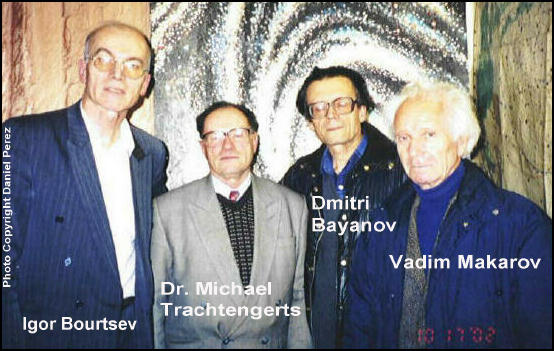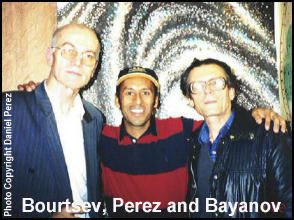Bigfoot Encounters
My Russian Bigfoot Trip
Last
month I journeyed to the mysterious land of Russia to find pit first-hand
what the Russian hominologists (as they call themselves) are doing in
terms of research and investigation into their own version of Almas or
Chuchunaa.
My main contacts were Russia's most famous Bigfoot investigators, Dmitri
Bayanov, 70, and Igor Bourtsev, 62 both fluent in English and with tremendous
expertise in one area: the Patterson-Gimlin film. Mr. Bayanov is retired
and very intellectual; Bourtsev, twice divorced now lives with his second
ex-' wife and is raising two charming teenage daughters.

I also had the unexpected pleasure of meeting two other distinguished
hominologists: Vadim Makarov, 73, both author and a witness to the Russian
wildman and Dr. Mikhail Trachtengerts, 65, scientist, hunter and fisherman.
Dr. Trachtengerts speaks effective English and Vadim Markarov is only
fluent in Russian, but I had little problem communicating with him.
Vadim Makarov became interested in the wildman sometime in the 1950s, uspicious there might be something more to the many tales of large, hairy manlike beings. In 1981 he had the rare privilege of actually seeing what might have been a young wildman in the middle of the night, only to see it vanish moments later. Well, he realized animals just don't disappear and found out the wildman had squatted behind some vegetation, creating the illusion of disappearing. He has just recently completed a book, published and written in Russian, Atlas Of The Snowman, 310 pages in length and profusely illustrated. I was lucky to get an autographed copy while I was there in Moscow, the home of Bayanov; Bourtsev; Trachtengerts and Markarov.
Moscow is a very different
world than what we are accustomed to in the United States. It is a mysterious,
cold and relatively unexplored world bustling with activity of people.
Walking here, there, everywhere, always in a hurry. Public transportation
is how they generally move about. You see, most of the Russian citizens,
(90%), do not own a car as the economics of ownership is out of reach.
Of the four just mentioned only Bourtsev owned an old car needy of repair...but
proud nonetheless to own one.
If you think the people in Los Angeles drive crazy, what until you get
a load of Moscow's drivers. It's a free for all, anything goes.., damned
if you do, damned if you don't drive by the seat of your pants. Traffic
cops are ever present and poorly paid, said to be the most corrupt organization
in all of Russia. If you are pulled over, I was told, the Russian ruble
(their money) usually gets you back on the road quickly, quietly and without
a ticket. I asked Igor Bourtsev, who did quite a bit of driving for me,
why all the new expensive cars were being pulled over and his reply was
something to the effect the police know they have money. (As a footnote,
the average Russian citizen earns less than $2000 per year).
While I was there a powerful car bomb injured 8 people at McDonalds, one
of my favorite stomping grounds. Valentin Tsvetkov, 54, governor of the
gold rich Magadan region was gunned down by a hit man with a 9-mm bullet
lodged into the back of his head. He died on the spot. His dead body lay
on a cold, wet sidewalk and his picture was splashed on the front page
of the Moscow, Times for all to see. Said the observant tourist sitting
next to me on the Aeroflot flight back to Los Angeles: "you don't
leave Russia, you escape!"
When I was back on American soil I found out, like you, that: the Chechen
rebels had invaded a Moscow theater and held quite a few hostage. This
fiasco played out on American television and sadly many innocent lives
were lost.
There is, of course, a brighter side to Moscow, home of more than 80 museums
that offer a fascinating insight into the history and culture of the people
of Russia.
St. Basil's Cathedral, in Red Square section of Moscow is Russia's most
enduring landmark and perhaps it is most beautiful as well. For this foreigner,
the beauty of the cathedral was beyond words.
I learned from Igor Bourtsev that Lt. Colonel V.S. Karapetian, the medical
examiner who was asked to examine a captive "wildman in the Caucasus
in December 1941 died a few years ago. Those who met Lt. Col. Karapetian
including the late René Dahinden were greatly impressed by his
incredible story.
Dmitri Bayanov told me he is not sure whether Dr. Dmitri Donskoy, an expert
in biomechanics who studied the Patterson-Gimlin film in great detail,
is still living, as he lives or lived outside of Moscow and is extremely
hard to get in touch with.
 Igor
Bourtsev told me the wildman tracks he observed and cast in the Gissar
Range in Russia, August 1979, was even bigger to him than the P-G film,
as it was an opportunity to view physical evidence firsthand, as opposed
to just studying a film shot in another country.
Igor
Bourtsev told me the wildman tracks he observed and cast in the Gissar
Range in Russia, August 1979, was even bigger to him than the P-G film,
as it was an opportunity to view physical evidence firsthand, as opposed
to just studying a film shot in another country.
While I was there,
an area called Kirov was the hotbed of current wildman activity, and I
was shown videotape of many large trees bent and busted over in a shelter
like formation.
When I left Russia I was fully convinced they, like North America, is
home to an unknown species of wild, hairy man-like animals. Said the gray
haired Vadim Makarov to me, "if they [the scientists] are not interested
in this I am not interested in them."
© Daniel Perez,
November 2002 Bigfoot Times
10926 Milano Avenue
Norwalk, California 90650-1638
Bigfoot Times Subscription rate is $11.00 US fund a year.
Portions of
this website are reprinted under the Fair Use Doctrine of International
Copyright Law as educational material without benefit of financial gain.
http://www4.law.cornell.edu/uscode/17/107.html
This proviso is applicable throughout the entire website.